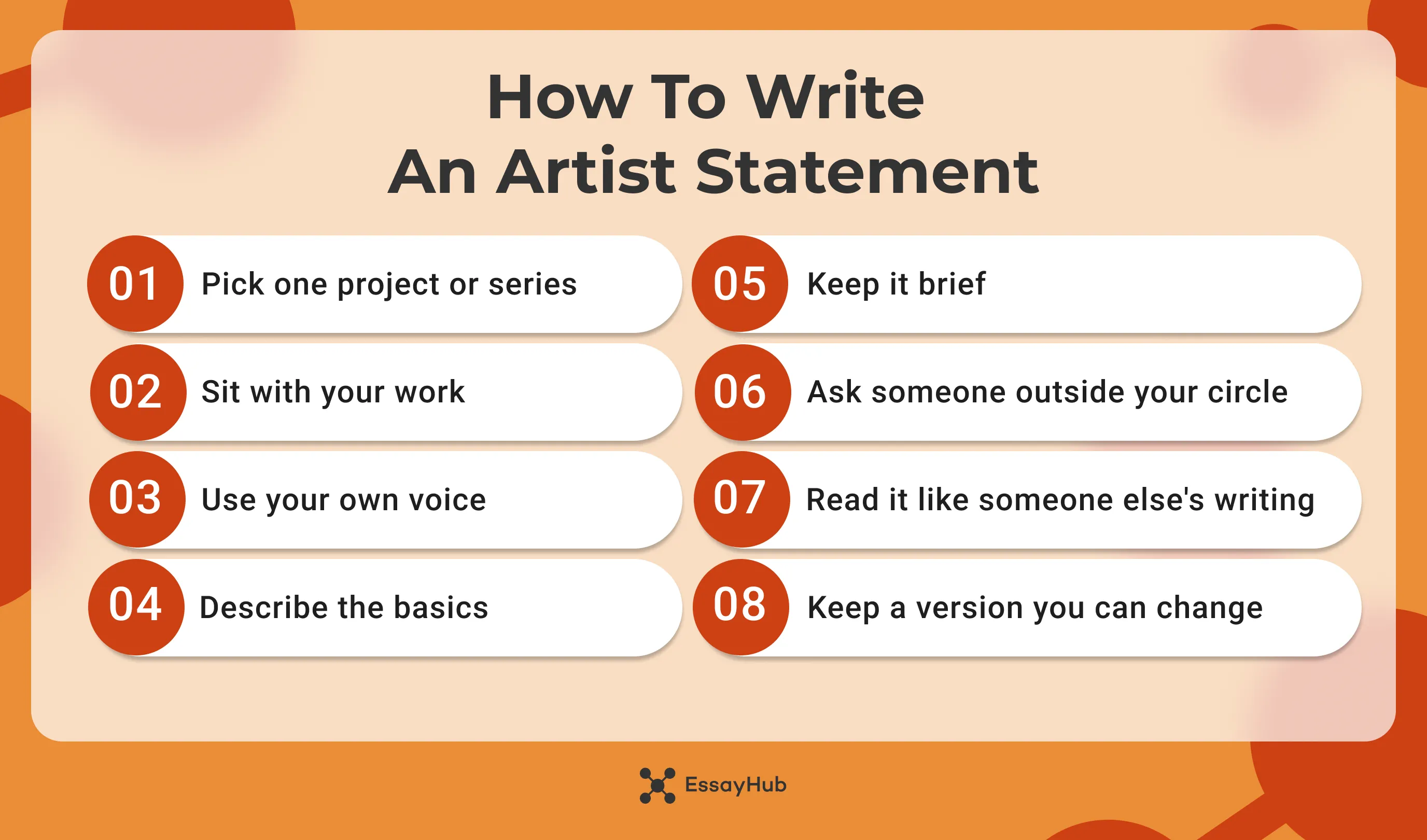An artist statement is a piece of writing, usually a short one, that explains an artist's work. It might sound simple, yet, it can often be the hardest thing to write sometimes. Before you get caught in the loop of trying to sound deep, let's start with the basics:
- Pick one project or series
- Sit with your work
- Use your own voice
- Describe the basics
- Keep it brief
- Ask someone outside your circle
- Read it like someone else's writing
- Keep a version you can change
This article will teach you the entire process of writing an artist statement step by step. And if no amount of guides and smart tips make the words come easily, that is okay, too. When writing gets hard, you can always rely on EssayHub's assignment writing services to help you with academics.
What Is an Artist Statement?
An artist statement is a short piece of writing where you put your craft into words. It describes your work, what it took to create it, and the motivation behind it. Unlike an artist biography, it's written in the first person. So, this is the part where your art gets a voice. An artist statement tells the story behind what you do, told clearly enough that someone standing in front of your work has context.
When Do You Need an Artist Statement?
Artist statements are used in gallery exhibitions, artist residencies, portfolio reviews, or grant submissions. Someone might ask for your artist statement when you're putting up your own website. And even if they don't, it helps to have one ready. Every time your work goes out into the world without you in the room to explain it, the artist statement becomes the stand-in.
What Goes Into an Artist Statement?
Artist statements should answer three questions: what, how, and why. The text should feel like a conversation, one where you finally get to talk about something that means the most to you.
- What: Describe the work in simple terms. Maybe you create digital illustrations based on old stories. Maybe you work with found objects or build with salvaged metal. Say what it is without dressing it up.
- How: Explain your process the way you would to a friend. Skip the buzzwords. Mention the tools, materials, and steps you take to bring the work to life.
- Why: Share what keeps you coming back to work. Just speak to the question or the feeling behind it.
How to Write an Artist Statement in 8 Steps
There's no magic sentence that sums up who you are as an artist. Nor is there a 'right' way to come up with that sentence. But you can always talk about your work honestly. The hardest part is starting, though, so once you're past that, the rest will show up. Now, let's walk through the process step-by-step.

Pick a Specific Work or Series
Start small. Don't try to cover your entire portfolio or sum up your evolution as an artist in one go. That's a trap that will only lead you to watering your work down. Pick a fresh or even an unfinished project, something that keeps tugging at your brain, and stick with that. You'll say more by zooming in than by stretching thin.
Look at What You've Made
Sit with your artwork. Not in a general sense, really look. Just because you created it doesn't mean you can write what it means right away. So, let it surround you. Forget the pressure to name a theme or a concept. Just sit with it and ask yourself:
- What do these pieces have in common, even without planning?
- What's the feeling that comes up when you see them?
- What kind of questions do they seem to be asking?
Let whatever you write at this stage be messy. Those fragments and repeats are what you'll build your artist statement on.
Use a Voice That Sounds Like You
This isn't the moment to flex your inner philosopher. No sentence that you wouldn't say to a friend belongs in your artist statement. Start with something as simple as "My work is about..." and see where it will take you. When writing an artist statement, imagine you're talking to someone who's genuinely interested but doesn't know the first thing about your medium. Not an artist or a professor, but someone listening.
Touch on the Basics
We've already covered this, but this part is extra important because it gives your reader something to hold onto. Say plainly what you make. No explanations at this point, just what it is without dressing it up. Then, let the reader see how the creative work happens: the tools you reach for, the space you work in: these details matter more than you think. Let the reader in just far enough to picture your artistic process.
Now comes the part that's a bit harder to put together - why this work? Why now? You don't have to explain the entire thing in excruciating detail, but you should still define why you are still thinking about this piece. That's the part people remember.
Keep It Brief
If you're wondering how long your artist statement should be, go shorter. One paragraph is often enough, two, if you're really saying something and not rambling. Your artist statement should include just enough for someone to feel a little closer to your work. Here's a golden rule: pay attention to your own reaction when you read it. If your eyes start to skim, cut. If a sentence feels sharp and true, keep it. But let the work keep some of its edges; you don't need to explain every decision.
Ask Someone Outside the Art World
Hand your draft to someone who wouldn't know an artist statement from a restaurant menu. That's exactly who you need. If it lands with them, you're on the right track. If your statement only clicks with people deep in the art world, it might be hiding more than it reveals.
- Can they tell you what your work is without guessing?
- Did they repeat anything back that surprised you or made you think, "Yes, that"?
- Was there a moment where they looked confused?"
Read It Like You Didn't Write It
Step away from it. Close your laptop and go do something that has nothing to do with art. Then come back and read your statement like someone else wrote it. Read it out loud because that's when the cracks show. You'll catch the parts that sound too careful, too foggy, too much like someone trying to explain instead of just speaking. And if a line sounds like something you'd actually say to someone who's paying attention, you can leave it right there.
Keep a Version You Can Change
Don't treat your writing like it's carved in stone, even if it's the final draft. Your work shifts, and your artist statement should shift with it. Save a version that feels honest for now, and then come to terms with the idea that you'll have to come back to it later. Keep in mind:
- Write one statement per project or series.
- Update when your focus or approach changes.
- Let your statement grow with you, not lock you in.
If you’re struggling to develop a central idea for any of your papers, you can use EssayHub’s free thesis statement generator to help you get started.
Traps to Avoid When Writing an Artist Statement
A perfectly good statement can fall apart if you write words that you don't mean. Here are a few common red flags that will make your writing sound confusing, or, in the worst case scenario, forgettable:
- Trying to sound important – Your statement shouldn't read like you're applying for a philosophy grant. Talk like you would in real life. Say what you mean, not what you think sounds impressive.
- Dodging the specifics – "My work looks at identity." Whose identity? In what way? Through what lens? Vague language signals that you're not close to your work yourself.
- Writing too much – Make sure your statement doesn't last longer than the human attention span. One strong paragraph is better than three that keep going in circles.
- Leaving out the 'why' – If you don't say what's pulling you toward this work, no one's going to feel that pull either. Even a messy answer is better than silence.
- Assuming the reader knows the context – Avoid references only other artists would get. If someone outside your circle doesn't know what you're talking about, you're speaking too narrowly.
- Copying the tone of other artist statements – This might be the biggest one. Reading other statements for inspiration is fine. But never lose your voice.
Closing Thoughts
A strong artist statement builds a bridge between your work and the person looking at it. The main thing it must be is real, written in a voice that sounds like you on your most creative day.
And if writing about your work makes you want to scrap the entire project and walk away, that's more than okay, too. You're probably too close to it, which is when some extra help can make a real difference. You can always count on EssayHub for professional academic guidance whenever you can't find the words. And we work with more than the artistic stuff, too. If you ever find yourself thinking, ‘Why can’t someone just write my personal statement for me? ’ you don’t need to look further than Essayhub.
FAQ
What Does an Artist Statement Look Like?
A good artist statement reads like a focused paragraph in the artist's voice. It avoids jargon and gives the reader just enough insight to feel more connected to what they're seeing. An artist statement describes your work and the artist's motivation behind creating it.
What Are the Three Parts of an Artist Statement?
An artist statement typically revolves around three key parts:
- What – a clear, specific description of what you make
- How – a brief explanation of your process or materials
- Why – your motivation, inspiration, or the question that drives the work
How Long Should an Artist Statement Be?
Shorter than you probably think. One strong paragraph, around 100 to 200 words, is usually enough. If it takes more than that to explain what your work is doing, you might be overexplaining.
- ARTIST STATEMENT HOW DO I WRITE SUCCESSFULLY ABOUT MY ART PRACTICE? INITIAL QUESTIONS What is an Artist Statement? When is an Artist Statement Used? (n.d.). https://www.saic.edu/sites/default/files/legacy/Artist_Statement.pdf
- How to Write an Artistic Statement. (n.d.). Www.uncsa.edu. https://www.uncsa.edu/admissions/how-to-write-an-artistic-statement/index.aspx



